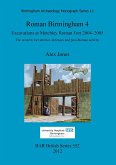Archaeological excavation, salvage recording and watching briefs were undertaken at Metchley Roman fort, Birmingham in 1999-2001 and 2004-2005. The areas investigated were located mainly to the west of the Roman military complex. The earliest features may have belonged to a construction camp (Phase A/ Phase 1A), preparatory to the layout of the first fort (Phase 1B), around AD 48. The western defences of this fort comprised double-ditches and a turf rampart. A new discovery was a palisade trench forming a western annexe or enclosure (Phase 1C) which may have been associated with the on-site manufacture of pottery, specifically mortaria. Most importantly, the excavations provided the first structural evidence for a civilian settlement at the site (Phase B). This comprised a total of six timber-framed structures, including three open-sided strip buildings, interpreted as shops, laid out along a gravelled trackway leading out of the fort. The western annexe or enclosure and the settlement were contemporary with the first fort. This short-lived settlement was succeeded by a complex of ditched livestock compounds (Phase C). A livestock 'funnel' leading to the fort's west gate was an integral part of this arrangement, confirming the nexus between the external livestock enclosures and the livestock enclosures previously recorded within the fort interior. Both the external and internal livestock enclosures belonged to the Neronian military stores depot (Phase 2B). The location of Metchley at an important road junction, and at, or adjoining, several tribal boundaries, could have proved important for the collection of livestock from the surrounding countryside. Assuming it was concerned with the supply of auxiliary rather than legionary units, Metchley is likely to have supplied forts within the local or regional area. The western livestock complex was abandoned by the early Flavian period. This zone to the west of the military complex was not brought back into use during subsequent occupations of the military complex, which continued up to the end of the 2nd century (Phases 3-4). With contributions from Lynne Bevan, Marina Ciaraldi, Hilary Cool, C. Jane Evans, Annette Hancocks, Kay Hartley, Rob Ixer, Erica Macey-Bracken, Wendy Smith, Jane Timby, Roger Tomlin, Roger White, Felicity Wild, David Williams, and Steven Willis Illustrations by Nigel Dodds and Bryony Ryder
Hinweis: Dieser Artikel kann nur an eine deutsche Lieferadresse ausgeliefert werden.
Hinweis: Dieser Artikel kann nur an eine deutsche Lieferadresse ausgeliefert werden.








